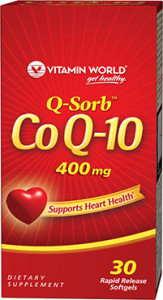Several more studies have been done that suggests the enzyme may help prevent heart damage done to individuals who are undergoing chemotherapy using adriamycin or other athracycline medications. (7) Studies of women who have breast cancer also suggest that in addition to conventional treatments Coenzyme Q10 may shrink tumors and reduce the pain associated with the condition. In these particular studies the experiences of the patients could not be attributed only to Coenzyme Q10 because other additional antioxidants were used, including Vitamin C, Vitamin E and selenium. The possibility exists that Coenzyme Q10, working in conjunction with these other antioxidants, is what affected the change in women who suffer from breast cancer.

Some new preliminary clinical studies also suggest that the enzyme has some beneficial effects in increasing sperm motility, as a part of the treatment for Alzheimer’s disease, to reduce the damage done from stroke, to boost athletic performance, to enhance the physical activity in individuals who suffer from chronic fatigue syndromes and to improve the exercise tolerance in individuals who have Muscular Dystrophy.
Coenzyme Q10 is found primarily in fish and meat. While we are able to produce some of it ourselves, the remainder must be synthesized from the foods that we eat or the supplementation we take. The highest amount is found in sardines and macral and the richest sources of vegetable Coenzyme Q10 are found in spinach, broccoli, peanuts and whole grains. In order to enjoy the benefits from vegetable sources they must be raw, fresh and unprocessed.
Using Coenzyme Q10 as a supplementation from outside of dietary sources comes with some possible drug interactions. Prior to initiating any supplementation purchased at a health food store or over the Internet you should check with your health care provider and pharmacist in order to determine that there are no drug interactions. Some of the drugs which are known to have side effects include several of the chemotherapy medications, blood pressure lowering medications, blood thinning medications and beta-blockers.
References:
(1) Basic Research in Cardiology: Coronary artery disease–free radical damage, antioxidant protection and the role of homocysteine
http://www.ncbi.nlm.nih.gov/pubmed/11192356
(2) Cardiovascular Research: The Role of Oxidants and Free Radical in Reperfusion Injury
http://cardiovascres.oxfordjournals.org/content/70/2/181.full
(3) American Family Physician: Coenzyme Q10
http://www.aafp.org/afp/2005/0915/p1065.html
(4) University of Maryland Medical Center: Coenzyme Q10
http://www.umm.edu/altmed/articles/coenzyme-q10-000295.htm
(5) Linus Pauling Institute: Coenzyme Q10
http://lpi.oregonstate.edu/infocenter/othernuts/coq10/
(6) University of California SanDiego: Preliminary Study Shows High-Dose Coenzyme Q10 Slows Functional Deline in Parkinson’s Disease Patients
http://ucsdnews.ucsd.edu/newsrel/health/101402Schults.htm
(7) University of Maryland Medical Center: Coenzyme Q10
http://www.umm.edu/altmed/articles/coenzyme-q10-000295.htm
| Advertisement | |
 |
|


Leave a Reply